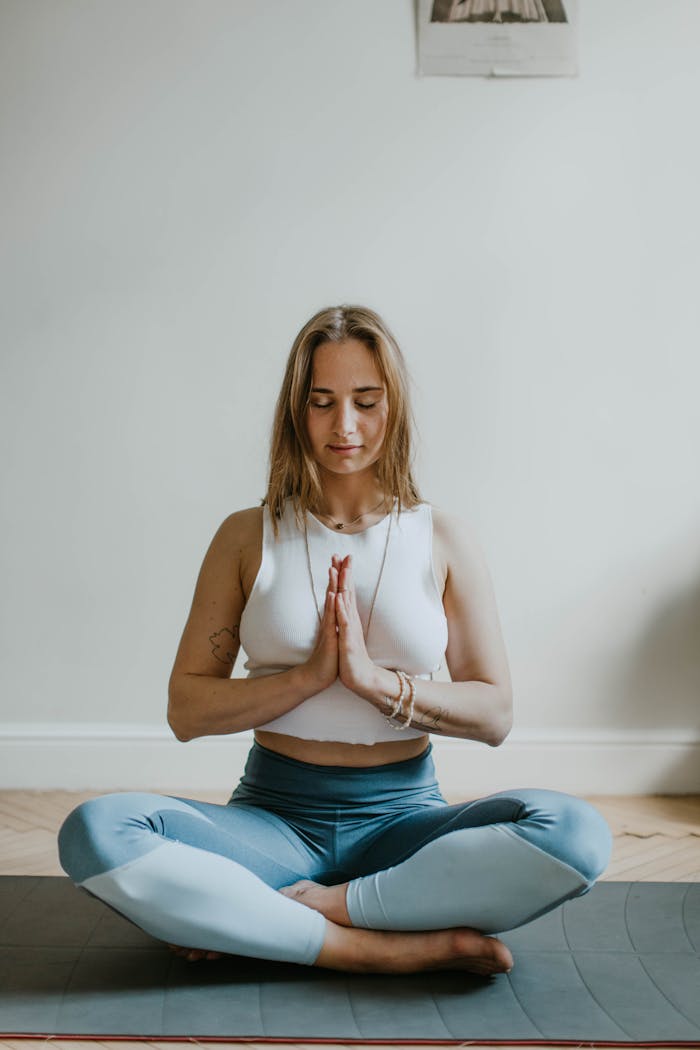Yoga is a holistic practice that integrates physical postures, breathing exercises, and meditation to promote overall well-being. One of the most significant benefits of yoga is its ability to reduce stress. For beginners, starting with simple yet effective poses can help ease stress and promote relaxation. This article will guide you through yoga poses that are perfect for beginners to reduce stress, along with detailed instructions on how to perform them.
1. Mountain Pose (Tadasana)
Benefits
Mountain Pose is a foundational yoga pose that promotes grounding and stability. It helps improve posture, balance, and concentration, making it an excellent starting point for reducing stress.
How to Perform
- Stand tall with your feet together and arms at your sides.
- Distribute your weight evenly across both feet.
- Engage your thigh muscles, lift your kneecaps, and draw your abdominal muscles inward.
- Relax your shoulders and lengthen your spine.
- Inhale deeply, lifting your arms overhead with palms facing each other.
- Hold for 5-10 breaths, focusing on your breathing and feeling grounded.
2. Child’s Pose (Balasana)
Benefits
Child’s Pose is a restorative pose that gently stretches the lower back, hips, and thighs. It calms the mind and relieves tension, making it ideal for stress reduction.
How to Perform
- Start on your hands and knees, with your knees slightly wider than hip-width apart.
- Sit back on your heels and extend your arms forward, resting your forehead on the mat.
- Breathe deeply and hold the pose for 1-3 minutes.
- Feel the stretch in your back and hips, and allow your body to relax.
3. Cat-Cow Pose (Marjaryasana-Bitilasana)
Benefits
Cat-Cow Pose combines two poses to gently warm up the spine, relieve tension in the back and neck, and promote relaxation.
How to Perform
- Start on your hands and knees in a tabletop position, with your wrists directly under your shoulders and knees under your hips.
- Inhale, arch your back, and lift your head and tailbone towards the ceiling (Cow Pose).
- Exhale, round your spine, and tuck your chin to your chest (Cat Pose).
- Continue to flow between Cat and Cow poses for 1-2 minutes, synchronizing your movements with your breath.
4. Standing Forward Bend (Uttanasana)
Benefits
Standing Forward Bend stretches the hamstrings, calves, and lower back. It also helps calm the mind and relieve stress and anxiety.
How to Perform
- Stand tall with your feet hip-width apart.
- Inhale, and raise your arms overhead.
- Exhale, hinge at your hips, and fold forward, bringing your hands to the floor or resting them on your shins.
- Relax your head and neck, and hold the pose for 5-10 breaths.
- To come out of the pose, bend your knees slightly, engage your core, and slowly roll up to standing.
5. Legs Up the Wall Pose (Viparita Karani)
Benefits
Legs Up the Wall Pose is a gentle inversion that promotes relaxation, reduces swelling in the legs, and calms the nervous system.
How to Perform
- Sit with one side of your body against a wall.
- Swing your legs up the wall as you lie down on your back, forming an L shape with your body.
- Adjust your distance from the wall so that your legs are comfortably supported.
- Rest your arms at your sides, close your eyes, and breathe deeply.
- Hold the pose for 5-10 minutes, allowing your body to relax.
6. Bridge Pose (Setu Bandhasana)
Benefits
Bridge Pose strengthens the back, glutes, and legs while opening the chest and heart. It helps reduce stress and mild depression by promoting relaxation.
How to Perform
- Lie on your back with your knees bent and feet hip-width apart, close to your buttocks.
- Place your arms at your sides, palms facing down.
- Inhale, press into your feet, and lift your hips towards the ceiling.
- Clasp your hands under your back and roll your shoulders underneath you.
- Hold for 5-10 breaths, then slowly lower your hips back to the mat.
7. Corpse Pose (Savasana)
Benefits
Corpse Pose is a final relaxation pose that allows the body and mind to rest and rejuvenate. It helps reduce stress, lower blood pressure, and promote overall relaxation.
How to Perform
- Lie flat on your back with your legs extended and arms at your sides, palms facing up.
- Close your eyes and take slow, deep breaths.
- Focus on relaxing each part of your body, starting from your toes and working up to your head.
- Hold the pose for 5-10 minutes, allowing your body and mind to fully relax.
8. Seated Forward Bend (Paschimottanasana)
Benefits
Seated Forward Bend stretches the spine, hamstrings, and lower back. It helps calm the mind and reduce stress and anxiety.
How to Perform
- Sit on the floor with your legs extended straight in front of you.
- Inhale, and raise your arms overhead.
- Exhale, hinge at your hips, and fold forward, reaching for your feet or shins.
- Relax your head and neck, and hold the pose for 5-10 breaths.
- To come out of the pose, engage your core and slowly rise back to a seated position.
9. Tree Pose (Vrksasana)
Benefits
Tree Pose improves balance, concentration, and mental clarity. It also helps ground the body and mind, reducing stress.
How to Perform
- Stand tall with your feet together.
- Shift your weight onto your left foot and place the sole of your right foot on your inner left thigh or calf (avoid the knee).
- Bring your hands to your heart in a prayer position or raise them overhead.
- Focus on a point in front of you to maintain balance and hold the pose for 5-10 breaths.
- Repeat on the other side.
10. Easy Pose (Sukhasana)
Benefits
Easy Pose is a simple seated posture that promotes relaxation and mental clarity. It helps reduce stress and anxiety by calming the mind.
How to Perform
- Sit on the floor with your legs crossed and your hands resting on your knees.
- Lengthen your spine and relax your shoulders.
- Close your eyes and take slow, deep breaths.
- Hold the pose for 1-5 minutes, focusing on your breath and allowing your mind to relax.
Tips for a Successful Yoga Practice
1. Create a Calm Environment
Find a quiet, comfortable space where you can practice yoga without distractions. Use a yoga mat for support and consider playing soft, calming music.
2. Focus on Your Breath
Breathing is a fundamental aspect of yoga. Focus on deep, mindful breaths to help calm your mind and reduce stress.
3. Listen to Your Body
Yoga is about finding balance and harmony in your body. Listen to your body and modify poses as needed to avoid discomfort or injury.
4. Practice Regularly
Consistency is key to reaping the benefits of yoga. Aim to practice regularly, even if it’s just for a few minutes each day.
5. Stay Present
Yoga encourages mindfulness and being present in the moment. Focus on your breath and movements, letting go of any stress or distractions.
Incorporating Yoga into Your Daily Routine
Integrating yoga into your daily routine can significantly enhance its stress-relieving benefits. Here are some tips on how to make yoga a part of your everyday life:
1. Morning Routine
Start your day with a few minutes of yoga to set a positive tone. Incorporate poses like Mountain Pose, Cat-Cow, and Seated Forward Bend to wake up your body and mind.
2. Midday Break
Take a break during your day to practice a few stress-relieving poses. Child’s Pose and Tree Pose are great options to help you refocus and recharge.
3. Evening Wind-Down
End your day with relaxing poses like Legs Up the Wall and Corpse Pose. These poses can help calm your mind and prepare your body for a restful night’s sleep.
4. Short Sessions
If you have a busy schedule, incorporate short yoga sessions throughout your day. Even five minutes of mindful breathing and stretching can make a difference.
Conclusion
Yoga is a powerful tool for reducing stress and promoting overall well-being. By incorporating these beginner-friendly poses into your routine, you can experience the calming and rejuvenating benefits of yoga. Remember to listen to your body, focus on your breath, and practice regularly to cultivate a sense of inner peace and balance. Whether you have a few minutes or an hour, making time for yoga can help you navigate the stresses of daily life with greater ease and resilience.



